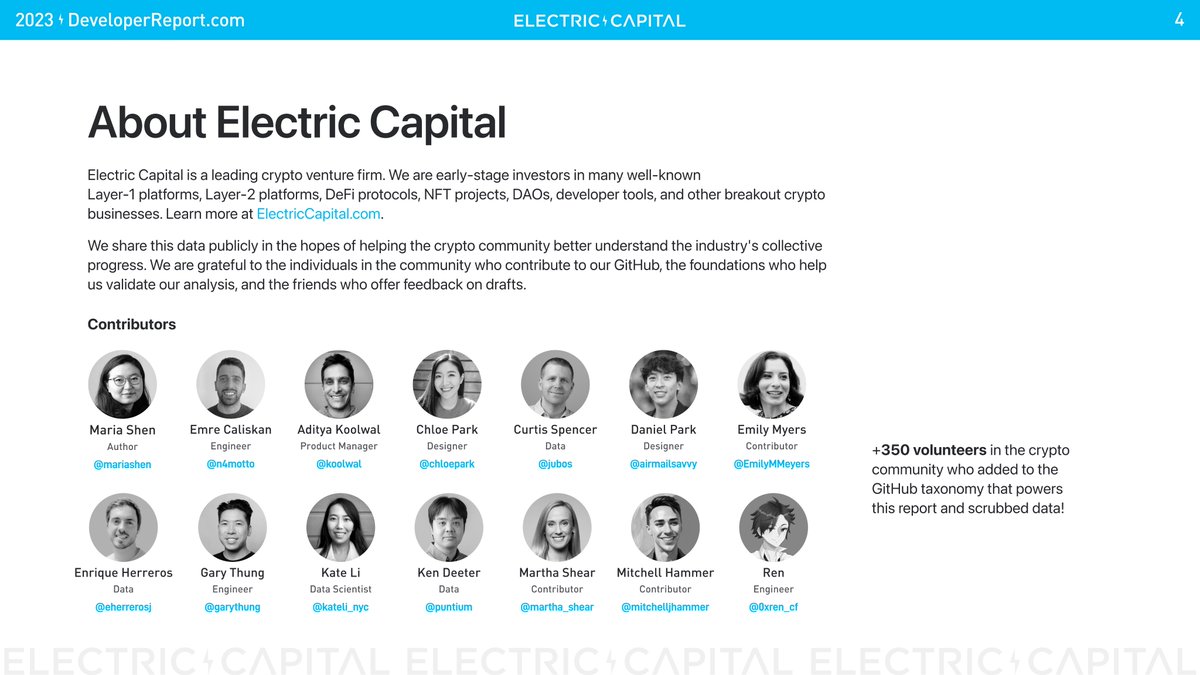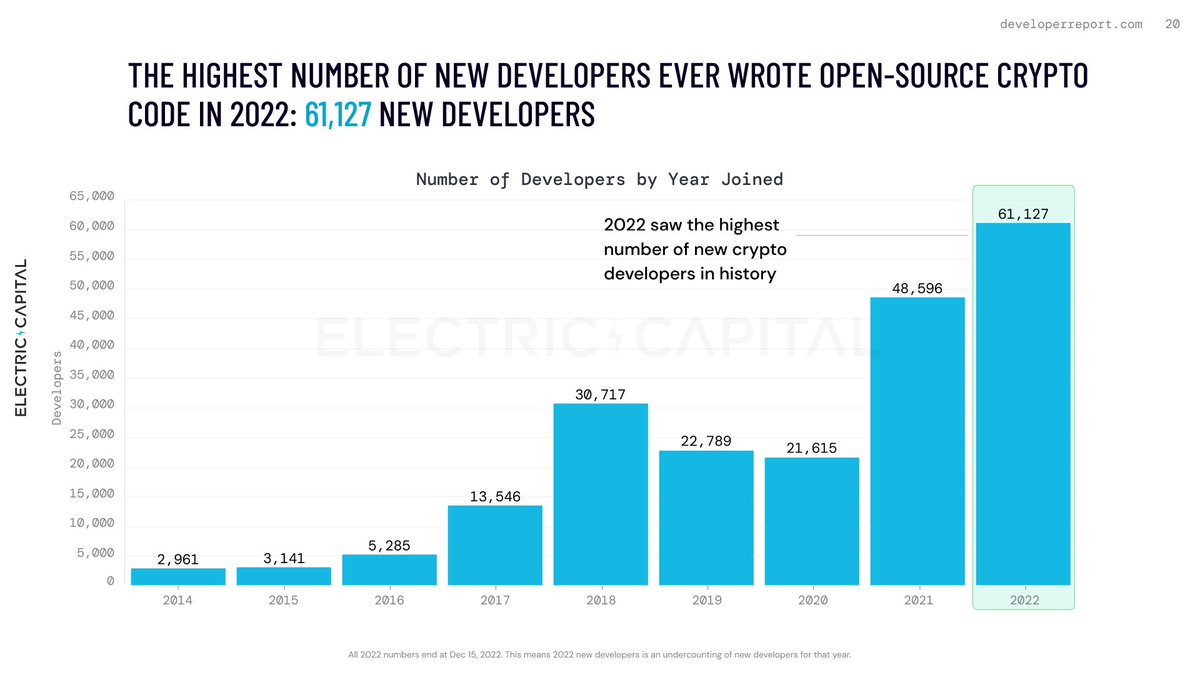1/ We are excited to introduce the @ElectricCapital Crypto Market Map!
The Crypto Market Map tracks 1,500+ projects in crypto.
It contextualizes every major project in crypto by organizing projects into 6 tech layers & 137 categories.
Let's explore 👇🏽 cryptomarketmap.org

The Crypto Market Map tracks 1,500+ projects in crypto.
It contextualizes every major project in crypto by organizing projects into 6 tech layers & 137 categories.
Let's explore 👇🏽 cryptomarketmap.org

2/ Important caveats:
- this undercounts the total projects in crypto. This map only incorporates major projects. Inclusion criteria is at the end of the thread.
- there are still gaps. The map is in beta & everyone can contribute to the map. Contribution details at the end.
- this undercounts the total projects in crypto. This map only incorporates major projects. Inclusion criteria is at the end of the thread.
- there are still gaps. The map is in beta & everyone can contribute to the map. Contribution details at the end.
3/ The Crypto Market Map contextualizes the role every major projects plays.
Projects are divided into 6 tech layers from infra to end-user-facing projects:
A - Core Infra
B - Scaling
C - Interop
D - Dev Tools & Services
E - Protocols
F - Applications
Projects are divided into 6 tech layers from infra to end-user-facing projects:
A - Core Infra
B - Scaling
C - Interop
D - Dev Tools & Services
E - Protocols
F - Applications
A. Core Infrastructure
This foundational layer includes projects like Bitcoin & other Layer 1 blockchains that expanded on Bitcoin's initial design.
Mining services, hardware manufacturers, & other infrastructure level projects are included in this layer.
4/
This foundational layer includes projects like Bitcoin & other Layer 1 blockchains that expanded on Bitcoin's initial design.
Mining services, hardware manufacturers, & other infrastructure level projects are included in this layer.
4/

B. Scaling
As usage of Bitcoin, Ethereum, & other Layer 1s increased, projects emerged to address scalability.
This layer includes Layer 2s, Layer 3s, & modular blockchain projects.
5/
As usage of Bitcoin, Ethereum, & other Layer 1s increased, projects emerged to address scalability.
This layer includes Layer 2s, Layer 3s, & modular blockchain projects.
5/

C. Interoperability
With more chains, the ability for information to transfer across chains has become crucial.
Projects in this layer focus on enabling inter-chain communication, data sharing, & asset transfer.
6/
With more chains, the ability for information to transfer across chains has become crucial.
Projects in this layer focus on enabling inter-chain communication, data sharing, & asset transfer.
6/

D. Developer Tools and Services
This layer catalogs tools, services, & data providers essential for developers & users.
It includes everything from development frameworks to data analysis tools.
7/
This layer catalogs tools, services, & data providers essential for developers & users.
It includes everything from development frameworks to data analysis tools.
7/

E. Protocols
These projects are characterized by rules that largely execute on-chain.
These projects span use cases across Decentralized Finance, NFT and Gaming, Social, Identity & Data Sovereignty, Privacy, and more.
8/
These projects are characterized by rules that largely execute on-chain.
These projects span use cases across Decentralized Finance, NFT and Gaming, Social, Identity & Data Sovereignty, Privacy, and more.
8/

F. Applications
These projects are characterized by rules that mostly do not execute on-chain.
These projects span use cases across Centralized Finance, Creator Platform, NFT & Gaming, Social, Identity & Data Management and Sovereignty, Privacy, and more.
9/
These projects are characterized by rules that mostly do not execute on-chain.
These projects span use cases across Centralized Finance, Creator Platform, NFT & Gaming, Social, Identity & Data Management and Sovereignty, Privacy, and more.
9/

10/ Caveat: The line between Protocols and Applications is not always distinct and many projects can be considered both.
This is because many applications in crypto have both off-chain & on-chain components.
138 projects are in 1+ category within the Crypto Market Map.
This is because many applications in crypto have both off-chain & on-chain components.
138 projects are in 1+ category within the Crypto Market Map.
11/ Why did we create the Crypto Market Map?
Crypto has become specialized & complex as it matures. Since we published a market map in 2019, crypto has shifted meaningfully.
We created the Crypto Market Map to provide an overview of the rapidly expanding industry.
Crypto has become specialized & complex as it matures. Since we published a market map in 2019, crypto has shifted meaningfully.
We created the Crypto Market Map to provide an overview of the rapidly expanding industry.
12/ In 2019:
- 500+ projects were in our market map (basically anything non-scammy we could find)
Today:
- 1,500+ projects, despite only accounting for significant projects
Here are 6 of the biggest shifts in crypto since 2019:


- 500+ projects were in our market map (basically anything non-scammy we could find)
Today:
- 1,500+ projects, despite only accounting for significant projects
Here are 6 of the biggest shifts in crypto since 2019:


I. DeFi is now a major category.
In 2019:
- DeFi was not its own category
- Uniswap & Compound launched <1 year prior
- DAI not yet launched
- All Defi TVL was <$500M
Today:
- DeFi has $85B TVL
- DeFi is the largest category w/ 394 projects + 14 subcategories
13/
In 2019:
- DeFi was not its own category
- Uniswap & Compound launched <1 year prior
- DAI not yet launched
- All Defi TVL was <$500M
Today:
- DeFi has $85B TVL
- DeFi is the largest category w/ 394 projects + 14 subcategories
13/
II. NFTs now underpin many apps
In 2019:
- most apps did not use NFTs
- popular NFTs like Cryptokitties were games
Today:
- NFTs underpin apps in games, music, art, loyalty, finance, identity, & more
- NFTfi emerged. 49 projects enable NFT lending, borrowing, & derivs
14/
In 2019:
- most apps did not use NFTs
- popular NFTs like Cryptokitties were games
Today:
- NFTs underpin apps in games, music, art, loyalty, finance, identity, & more
- NFTfi emerged. 49 projects enable NFT lending, borrowing, & derivs
14/
III. Scaling & interoperability projects are maturing.
In 2019:
- 17 L2 projects
- 8 interoperability projects
Today:
- 73 major L2s
- L3 projects appeared
- Modular is a new category w/ 60+ major projects
- Intent & Account Abstraction is a new category w/ 11 projects
15/
In 2019:
- 17 L2 projects
- 8 interoperability projects
Today:
- 73 major L2s
- L3 projects appeared
- Modular is a new category w/ 60+ major projects
- Intent & Account Abstraction is a new category w/ 11 projects
15/
IV. Consumer-facing apps & protocols are growing.
In 2019:
- only 30 major gaming projects
- most user-facing apps were for resource coordination
Today:
- 121 projects across games, gaming platforms, & metaverses
- 110 projects across social applications and protocols
16/
In 2019:
- only 30 major gaming projects
- most user-facing apps were for resource coordination
Today:
- 121 projects across games, gaming platforms, & metaverses
- 110 projects across social applications and protocols
16/
V. Innovative tech have moved from theory to practice.
Using zero-knowledge tech as an example...
In 2019:
- zk was used by a few pioneering projects like Zcash
Today:
- 159 projects in the Crypto Market Map utilize zk tech
17/
Using zero-knowledge tech as an example...
In 2019:
- zk was used by a few pioneering projects like Zcash
Today:
- 159 projects in the Crypto Market Map utilize zk tech
17/
VI. Categories consolidate as they mature.
In 2019:
- Smart Contract Platforms & Exchanges were the largest categories
Today:
- Both have not significantly grown bc users & devs consolidated to fewer platforms
We expect consolidation in other categories as they mature.
18/
In 2019:
- Smart Contract Platforms & Exchanges were the largest categories
Today:
- Both have not significantly grown bc users & devs consolidated to fewer platforms
We expect consolidation in other categories as they mature.
18/
19/ The intent of the Crypto Market Map is to include projects that have significant industry or cultural relevance.
The projects in this market map come from a pool of thousands of crypto projects.
The projects in this market map come from a pool of thousands of crypto projects.
20/ Projects must have at least 1:
- $2M+ funding since 2023 & active updates
- $50M+ funding & active updates
- 50+ devs in 2024
- top 100 mktcap
- leading DeFi project on a chain
- 10K+ followers on Twitter
- play a leading or significant role in a chain’s ecosystem
- $2M+ funding since 2023 & active updates
- $50M+ funding & active updates
- 50+ devs in 2024
- top 100 mktcap
- leading DeFi project on a chain
- 10K+ followers on Twitter
- play a leading or significant role in a chain’s ecosystem
21/ Projects NOT included:
- hackathon projects
- projects that do not show intention of shipping products that they initially announced
- projects where the shipping timeline is potentially too far in the future
- hackathon projects
- projects that do not show intention of shipping products that they initially announced
- projects where the shipping timeline is potentially too far in the future
22/ The Crypto Market Map is incomplete & in beta. Please help improve it!
We reviewed thousands of projects, but there are still gaps:
- projects may be missing due to gaps in data sources
- categorization may be subjective
Contribute here:
airtable.com/appQG8Z7XNVDQz…
We reviewed thousands of projects, but there are still gaps:
- projects may be missing due to gaps in data sources
- categorization may be subjective
Contribute here:
airtable.com/appQG8Z7XNVDQz…
23/ Read about our motivation, methodology, & crypto landscape changes here:
cryptomarketmap.org/about
cryptomarketmap.org/about
This is a team effort! Follow the creators for more crypto knowledge:
Research:
@0x9e0ff
@0xren_cf
@garythung
@mitchelljhammer
@puntium
@sanjaypshah
@sidmvenkat
@swatimardia
Design:
@chloepark
@mishafrolov
Eng:
@lucasg_dev
@sheatgm
Review:
@martha_shear
@EmilyMMeyers
Research:
@0x9e0ff
@0xren_cf
@garythung
@mitchelljhammer
@puntium
@sanjaypshah
@sidmvenkat
@swatimardia
Design:
@chloepark
@mishafrolov
Eng:
@lucasg_dev
@sheatgm
Review:
@martha_shear
@EmilyMMeyers
Lastly, a BIG thank you to everyone who gave feedback! 🙏
@Flynnjamm, @masoncags, @mraltantutar, @MSilb7, @next_roy, @shanefanx, @szenics, @WaverlyMaven, @whizwang
@Flynnjamm, @masoncags, @mraltantutar, @MSilb7, @next_roy, @shanefanx, @szenics, @WaverlyMaven, @whizwang
Disclosures: This Content is for Informational Purposes Only
We may have previously held, currently hold, or will in the future hold tokens or equity in some of the projects mentioned in this map.
Nothing in this map should be construed as financial advice.
We may have previously held, currently hold, or will in the future hold tokens or equity in some of the projects mentioned in this map.
Nothing in this map should be construed as financial advice.
• • •
Missing some Tweet in this thread? You can try to
force a refresh























